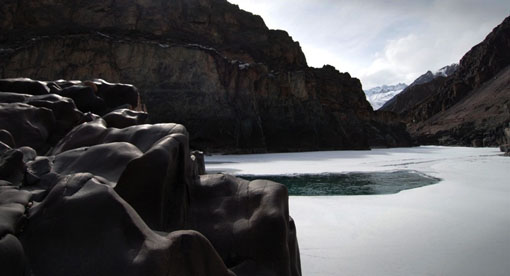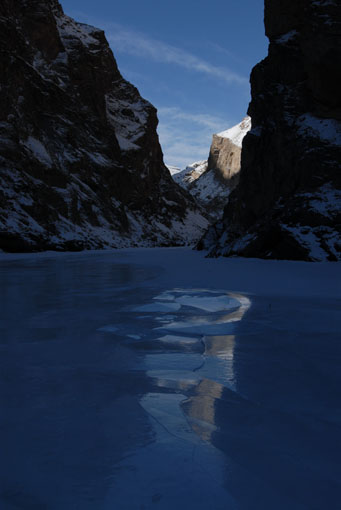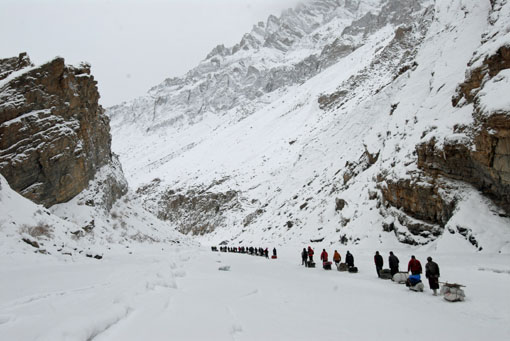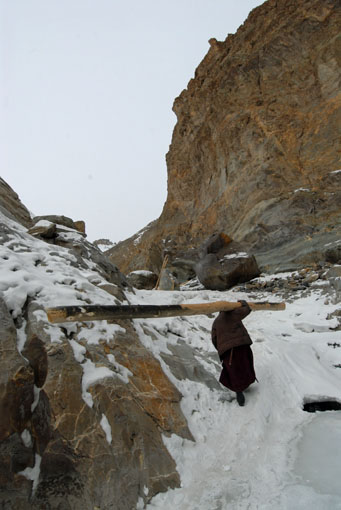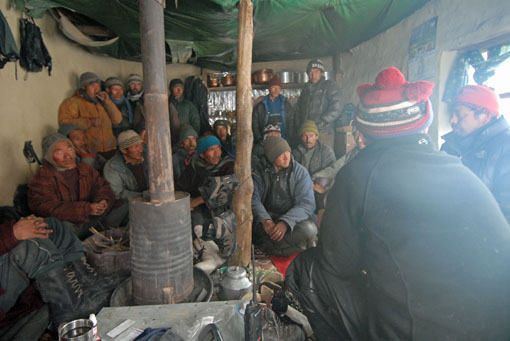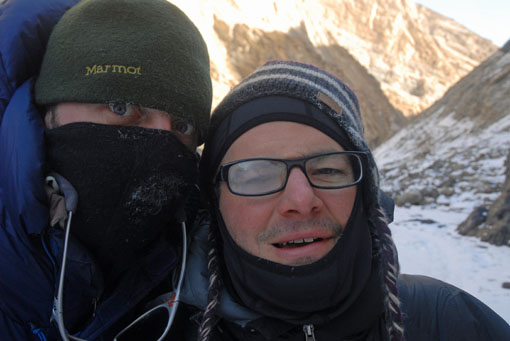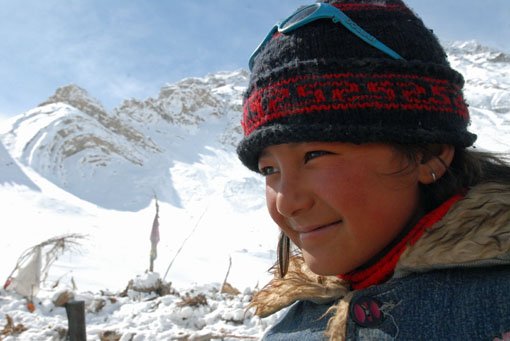Slip Sliding in Ladakh
by Robin Cox, freelance cameraman, Human Planet
Snow covered our footsteps as we retreated from Pidmo. It had been snowing on and off for a week, the flat roofs of every mud brick house were thick with it and the residents acknowledged our departure as they shovelled their rooftops.
Three days earlier we had advanced downstream on the frozen Zanskar river from Zangla, a mere 8.5km, with the intention that we would progress further the next day to begin our filming. The Chadar, or “sheet” as the iced river is known in winter, had proved to be in poor shape that day. Sections of solid ice gave way frequently to slushy margins and became impassable so we had to resort to the river banks, ploughing through waist deep snow. It was exhausting in the extreme, no step ever finding a sound footing. Two of our heavily laden porters had been ekeing out every bit of open ice when they overwhelmed the thin crust and crashed through. Climbing out, soaked to the skin, they marched on before they froze. No surprise then, that on our arrival at Pidmo morale was low.
The week’s snow had wrecked the length of the Chadar, a hundred avalanches had swooped down onto the ice, puncturing the river’s skin and damming its flow. The pressure then built beneath the surface of the ice and blew huge holes in the ice sheet, as though a giant’s fist had struck it. Water had flooded over the ice, flushing loose shards down stream till they piled up like flotsam against the snowy dam. Some less fortunate than us had been walking on the river when the avalanches occurred. One man, a worker building a new road in the valley, was trapped under an avalanche and sadly perished; others had been forced to wade up to their waists through the icy flood waters to reach safety.
Our mission was to film eleven children and seven fathers as they walked the six day trek along the frozen river from Zangla, a 4000m high mountain village in the Zanskar region of the Tibetan Plateau. Their destination the town of Leh, where the children were being returning to school after the winter holiday. This yearly pilgrimage is routine for the people of the area. The Chadar forms a seasonal highway through stunning gorges, allowing relatively easy access out of the mountains, impossible by road during the winter months when the mountain passes are closed by snow. It is usually traversed without great difficulty and we ourselves had walked upstream on smooth firm ice just a week before with smiles on our faces. The river had been alive with local people marching in both directions, carrying goods of all kinds.
We had been told that in living memory there had been no deaths in avalanches and only two deaths due to drowning when the ice had given way in the spring. We had felt confident that our return trip would be just as easy. To be extra cautious we had left an extra week to make it down the river well before the end of February when traditionally the ice begins to melt and the Chadar becomes perilous. This year the un-seasonal snow had changed everything, and it began to seem as if our film was ill-fated.
Now we found ourselves in retreat - a great caravan of fifty porters carrying our 600Kg of film kit, camping gear and supplies. Days earlier when we started optimistically from Zangla, we had begun to hear the bad news… ‘the worst Chadar I have ever seen’ said one local when we arrived in Pidmo and dissent began to spread through our porters. A meeting was held with the fathers and guides while the porters had their own out in the snow, a shop stewards meeting of a kind. The consensus was not good, nobody was willing to go further so a retreat back to Zangla was the only option.
The river was torturously hard going so we walked on the road, relentlessly trudging in deep snow, navigating a path by telegraph poles, a beaten army returning from battle. The 8.5km took an aching six and a half hours; it was last light as we clawed our way into Zangla and back up the steps of Stanzin’s house, one of the fathers with whom we were staying. We collapsed - the altitude and snow had pushed us to the extreme. Too breathless to talk, David the director asked me to phone the producer, Mark Flowers, back in the UK to let him know of our retreat. Over the next 24 hours a plan to evacuate by helicopter formed and we contemplated abandoning the film.
There was only one chance to save the situation. The fathers told us that given a good spell of clear cold weather, just maybe the ice would heal and we could try again. We decided to sit it out. Next morning the sun shone in a deep blue sky. Hopes were raised and rescue postponed. One clear day followed another as we eagerly awaited news of an arrival from downriver that would signify it was once more passable. We played ball with Stanzin’s daughter and son, Dolkar and Chosing, on the rooftop whilst our guides kept an eye on the distant river. We washed our stinking thermals and waited… but no-one came.
Fears grew that the Chadar was finished for the year. We were washed around in a sea of consternation, trying to find a way to rescue the film before we were evacuated. Finally we formed a plan: we would film with just Stanzin and his two children walking as far as they could before being forced to turn back by the obstacle that lay somewhere downstream… at least we would have something to show for our toil. So three days after returning beaten to Zangla we set out once more for the river. We followed the trail of a snow-plough clearing the route to the road builders’ camp to bring home the dead worker’s body. Like a funeral procession, we followed the rattling machine to the ramshackle camp; the atmosphere in the camp was sobering. The porters again began to lose heart and more negotiations followed. Having successfully talked them round, we set out early the next morning.
It was icy cold, -30C, a bitter but sweet climate in light of our prayers for the Chadar to be safe. We clambered over the avalanches in silence, spread out to minimise risk, and advancing as fast as we could to get past the east facing slopes before the heat of the rising sun caused further falls. By lunchtime we had arrived safely back on the frozen river. The section we found ourselves on seemed solid enough, but as we ventured downstream the havoc the avalanches had wrought on the river became obvious, and there were still monumental obstacles out of sight for still no-one appeared from downstream. We filmed for two days, making the most of the weather until we reached a pool of open water only negotiable by means of clambering over a narrow rocky ledge. What seemed impossible for us to negotiate, seemed a breeze for the kids, but we felt we could go not go further with our equipment and returned to camp for the night. It seemed our story was over, all that remained to do were a few shots the following morning and then we would retreat to await the airlift. We had done our best in the circumstances.
I awoke the next morning to the familiar sleeping bag, iced by my night’s breath. There was much chatter in the camp and the chef was singing and shouting, which was not unusual, but there was a good vibe in the air. We gradually surfaced, squeezing into our rock hard boots and many thermal layers. Nick, the sound recordist, (always first into the mess tent for hot tea with chef) was greeted by good news. Max, David and I joined him and heard it too. That morning, at the crack of dawn, two men had arrived from down river, they had made it, the ice was apparently back, rough in places but sound and passable… suddenly our story was saved. Later that morning, twenty-one days after leaving Leh, we began to walk the Chadar to school with Dolkar, Chosing and Stanzin and the real film began. I have never known such a roller coaster of a shoot, or ever been away so long and achieved so little with the very real prospect of coming home empty handed.
We reached the school in Leh on the last day of the holidays and proudly sent Dolkar in her crisp new uniform with her brother through the school gates to begin their new term. Mission complete, we headed for the comfort of a hotel. Father Stanzin turned on his heel to start the return trip back to Zangla. He was only halfway through his journey, but as usual he took it in his stride.
